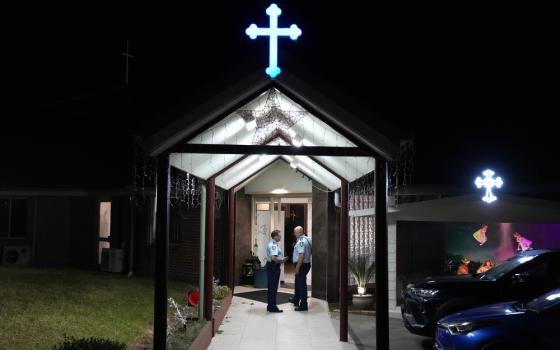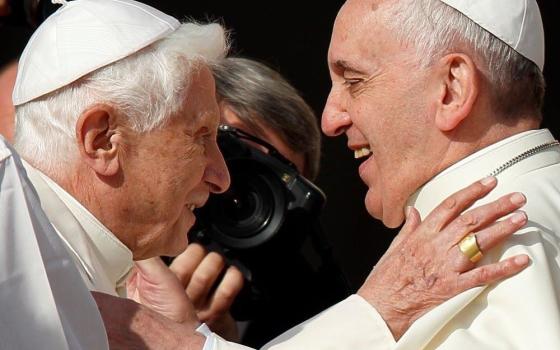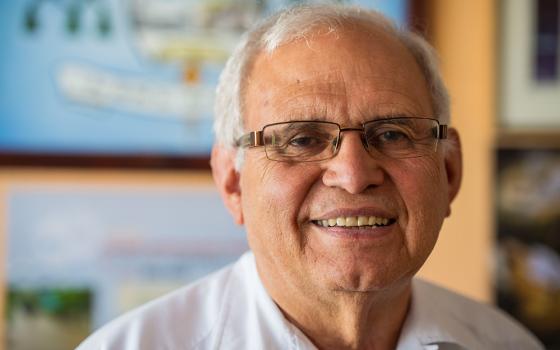This week, Benedict XVI once again finds himself in a nation whose Catholic community has been rocked by repeated sexual abuse scandals, and once again the pope appears determined not to duck the issue. As he did in his mid-April trip to the United States, Benedict addressed the crisis before he even arrived, taking a question aboard the papal plane en route to Australia for World Youth Day.
(Coverage of World Youth Day can be found here: http://ncrcafe.org/blog/2682)
Echoing points he made in the United States, the pope told reporters that it's "essential for the church to reconcile [with victims], to prevent, to help, and also to see guilt in these problems." In a little-noticed coda, however, Benedict went a step further than he did in America, identifying a potential culprit underlying the crisis: a moral theory known as "proportionalism."
Here's what the pope said, in English, according to the official Vatican transcript of his remarks:
"We have to reflect on what was insufficient in our education, in our teaching in recent decades. There was, in the '50s, '60s and '70s, the idea of proportionalism in ethics: It held that nothing is bad in itself, but only in proportion to others. With proportionalism, it was possible to think for some subjects -- one could also be pedophilia -- that in some proportion they could be a good thing. Now, it must be stated clearly, this was never Catholic doctrine. There are things which are always bad, and pedophilia is always bad. In our education, in the seminaries, in our permanent formation of the priests, we have to help priests to really be close to Christ, to learn from Christ, and so to be helpers, and not adversaries of our fellow human beings, of our Christians."
So far, Benedict's aside hasn't received much scrutiny amid overall gratitude for his candor. Eventually, however, it will have to be critically examined, which at one level is a task for specialists and historians. (Redemptorist moral theologian Fr. Brian Johnstone of the Catholic University of America, for example, points out that if nothing else, the pope's dating is off. Benedict referred to the influence of proportionalism "in the '50s, '60s and '70s," yet it didn't come on the scene, Johnstone said, until the mid-60s.)
The question is of broader importance, however, because finding a cure for the crisis depends upon accurate diagnosis. In that sense, what Benedict said about proportionalism -- even if most Catholics couldn't define the term -- concerns them all.
* * *
Before getting into that, some background on proportionalism is in order.
In the early part of the 20th century, a growing number of Catholic ethicists were voicing frustration with the tools and methods of moral instruction then in use, broadly known as the "manualist" tradition. At the time, manuals of Catholic morality were composed chiefly of rules derived from natural law and backed up by quotes from Scripture. Critics argued that such an approach was too abstract and impersonal, with principles often simply asserted rather than explained.
Following the Second Vatican Council (1962-65), the search began in earnest for a new framework. A German Jesuit named Fr. Peter Knauer offered one such approach, which would eventually come to be known as "proportionalism." In simplified terms, Knauer's argument was that actions are never morally good or bad in the abstract -- rather, their morality depends upon the circumstances, especially one's intent and the "proportion" of good versus evil the act is likely to produce.
As the "proportionalist" view was elaborated by others, including American Jesuit Fr. Richard McCormick, it famously came to distinguish between "pre-moral" or "ontic" good and evil, and "moral" good and evil. For example, one can say in the abstract that killing a human being is an "ontic" evil, but whether it's morally wrong depends on the circumstances. Self-defense, to take one instance, could render killing "proportionate."
Most immediately, proportionalism emerged from the ferment just before and after Pope Paul VI's controversial 1968 encyclical Humanae Vitae, reiterating the church's ban on artificial birth control. The theory offered a way for moralists to avoid a direct assault on the pope's teaching, yet still conclude that under some circumstances birth control could be justified. Over time, such reasoning was extended to other topics such as homosexuality, abortion and divorce.
While debate over those issues has obviously not gone away, most analysts say the high-water mark for proportionalism as a moral theory came in the 1970s. It's been in retreat ever since, they say, due to a mounting number of challenges.
Some moralists charge that whatever proportionalists say in theory, in practice they eviscerate moral absolutes. That's the primary basis upon which the magisterium, or the official teaching office of the church, has rejected proportionalism. In his 1993 encyclical Veritatis Splendor, in paragraphs 75-83, John Paul II writes that Catholic moral teaching posits the existence of "intrinsically evil" acts which may never be committed, whether or not they strike a positive proportion of good over evil.
More acidly, some critics have charged that proportionalism is little more than a license for dissent from official Catholic teaching. Some ethicists also warn that proportionalism leads to a "slippery slope," in which a narrow exception to a formerly iron-clad rule gradually becomes routine. Abortion and birth control are often cited as cases in point.
To an extent, such objections appeal more to the conservative wing of Catholic theology. Others are broadly shared, even among theologians sympathetic to some of the particular conclusions reached by proportionalists.
For example, many analysts say the basic flaw with proportionalism is that it assumes goods and evils are "commensurate," meaning that they can be ranked, measured, and compared. In reality, these experts say, such assessments inevitably become apples-and-oranges exercises.
We can weigh a Honda versus a Hummer, as disparate as those vehicles may be, because there are common terms of measurement -- purchase price, gas mileage, seating capacity, and so on. However, in weighing the destruction of a human embryo against the potential of finding a cure for Alzheimer's, these critics say, no such common standard exists. In fact, it's precisely this "incommensurability" of goods and evils that makes moral choice so agonizing.
Without any rational standard by which the proportion between good and evil can be assessed, these analysts say, proportionalism reduces morality to a matter of instinct too easily swayed by self-interest or personal inclinations.
On another front, critics also charge that proportionalism presumes a God-like view of the future that human beings simply can't attain. We can never know what all the consequences of a given act will be, so the kind of analysis implied by proportionalism is beyond our capacity.
In light of such objections, many theologians say that proportionalism, as a theory, is today all but extinct. Jesuit Fr. James Keenan of Boston College describes proportionalism as a "phase," "a bridge to get us to somewhere else," after the manualist tradition broke down.
* * *
As should be clear, there may well be legitimate reasons to question proportionalism as a moral theory. But what about its purported link to the sexual abuse crisis, which was the substance of Benedict XVI's statement?
Here, opinions seem mixed.
Some voices in the church are inclined to agree, arguing that it can't be mere coincidence that the volume of acts of sexual abuse by priests peaked in the 1960s and '70s, at precisely the moment when revisionist theories that weakened moral absolutes had the greatest influence in seminary instruction.
In a 2005 lecture at the Kenrick-Glennon Seminary in St. Louis, Archbishop Raymond Burke (recently appointed prefect of the Apostolic Signatura) linked proportionalism to the sexual abuse crisis.
"When the error of consequentialism or proportionalism was taught in seminaries, it was harmful in two ways. First of all, it risked the compromise of the moral life of the future priest, and, second, it prepared the future priest to propagate the error in his teaching and counsel of others," Burke said.
In broad strokes, Catholic author George Weigel concurs. I reached Weigel in Cracow, where he's taking part in an annual summer seminar on Catholic social teaching.
"If you graph the incidence of sexual abuse over the years, using the John Jay College figures, there seems to have been a spike in the years in which the teaching of moral theology in American seminaries downplayed the notion of 'intrinsically evil acts,' " Weigel said. "It's hard to imagine that didn't have something to do with the corruptions that led to the spike."
Weigel conceded that "no serious moral theologian using proportionalist methods would ever describe the sexual abuse of an adolescent boy as a moral good." Nonetheless, he said, "this meltdown in the idea of absolute norms was, if you will, the moral-theological component of a culture of clerical self-deception and auto-absolution."
Other experts, however, are skeptical.
Margaret Smith, data analyst for a John Jay study of the "causes and context" of the sexual abuse crisis commissioned by the U.S. bishops, cited two difficulties with the theory that proportionalism is to blame.
First, she said, the John Jay research found incidents of sexual abuse as far back as 1950, the very beginning of the time frame the bishops asked them to consider (1950-2000). Obviously, those acts of abuse cannot be explained by proportionalism. Second, she said, there was a "dramatically lowered incidence" of abuse among priests who graduated the seminary in the 1980s, some of whom were formed in the 70s when proportionalism was still in vogue. As a result, Smith said, if anything, proportionalism is "arguably associated with a decrease rather than an increase" in abuse.
Smith stressed that the portion of the "causes and context" study dealing with seminary instruction is not complete, and that further research may yet establish a connection between proportionalism and abuse. Further, Smith said, the results which have come in suggest that changing attitudes towards authority in the '60s and '70s, as well as a growing individualism in the broader culture, may well have played a role -- and that, she said, was perhaps the point Benedict "was reaching for."
Nonetheless, Smith said, her hunch is that when all the data is in, proportionalism will not loom large.
"This is behavior much more deeply embedded in the personality of individuals than a particular theory of moral action," Smith said. "I think the analysis of causes will have more to do with things like preparation for living a life of celibate chastity, and how to understand and deal with intimacy."
Keenan, who says he's not a proportionalist but is sympathetic to some of what they were trying to achieve, likewise expressed doubt about any connection between proportionalism and the crisis.
In fact, Keenan said, figures such as McCormick might have questioned the status of moral absolutes, but in practice they referred to "virtually exceptionless norms," meaning acts so abhorrent that it's all but impossible to imagine circumstances in which they might be justified. As examples, Keenan said, proportionalists routinely invoked the torture or rape of children.
"During this time period, people were trying to figure out whether you could practice contraception, not commit rape, Keenan said. "I don't know of a moral theologian in the world who would say that pedophilia is not always wrong."
Johnstone, who over the years has been critical of proportionalism, agreed. He called it "unthinkable" that anyone familiar with the theory could have used it to justify the sexual exploitation of minors. As a result, Johnstone said, he's "totally unconvinced" of any connection between proportionalism and the abuse crisis.
Keenan argued that broader factors such as the overall formation process in seminaries, and not the content of theological debates, ought to be the focus of attention.
"I find it hard to think that the classroom was the breeding ground of licentiousness," Keenan said.
* * *
Obviously, Benedict XVI has put his finger on a question where reasonable people will reach different conclusions, and no single perspective is likely to have all the truth.
On the one hand, it's hard to believe that the collapse of traditional moral verities in the 1960s and '70s, commonly known as the "sexual revolution," didn't play some role in fomenting an unusually high number of sex abuse cases in that period. On the other, it also strains credibility that blame for the crisis should be laid at the feet of serious theologians such as Knauer and McCormick. Whatever the defects in their theory, one suspects that if proportionalism had never come down the pike, abuser-priests would have found some other way to rationalize their behavior.
Which way church officials come down will have important policy consequences. If the diagnosis is that a defective moral theology helped to generate the crisis, then the antidote would seem to be increased doctrinal vigilance, along the lines of the recent Apostolic Visitation of American seminaries.
If, however, what happens in the classroom is ultimately judged to be less decisive than what happens outside, then such efforts could be misplaced. They may risk stifling the intellectual debate to which seminarians should be exposed, without any -- pardon the term -- "proportionate" benefit in terms of preventing abuse.
At a minimum, one thing seems clear.
As difficult as it may have been for Benedict XVI to publicly acknowledge the pain caused by the crisis, and to meet with victims, in many ways that was the easy part. Assigning responsibility and adopting remedies is, in the end, even more complex. Depending upon how he proceeds, the pope may find that the universal applause generated by his candor gives way to more mixed reviews.
The e-mail address for John L. Allen Jr. is jallen@ncronline.org




